Did you know that nanocrystals are responsible for the color of a chameleon?
From independently moving eyes to a rapidly moving tongue, chameleons have another very fascinating ability: They are able to change thier colour. But what have nanocrystals to do with a chameleons color? Taking a closer look at nature, plants appear green because of chlorophyl which reflects yellow and green light, our hair color depends on how much melanin we have got in our hair cells, but what is determining the color of a chameleon?
Chameleons in general
Chameleons spread into over 200 species and are well known for their ability to change their color from red to green, purple, turquoise, pink, brown, white, red, orange or yellow. During the last years, research has collected some very interesting facts about this process found out, it includes nanocrystals!
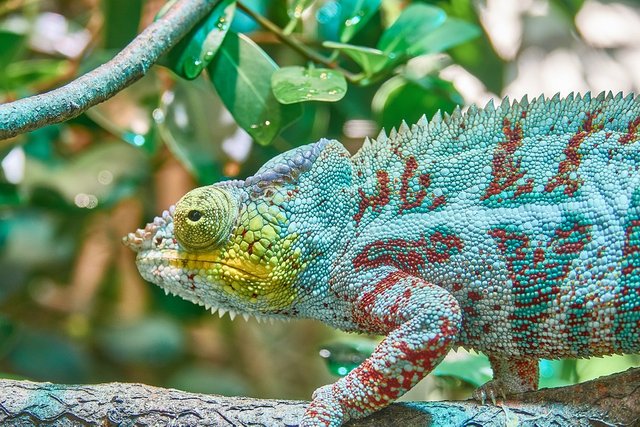
Chameleons mostly live in warm habitats from rainforest to even desert conditions. From Madagascar to southern Europe or the Middle East members of their species can be located. They differ in size: Some are just bigger than a centimeter, whereas others are longer than 50cm. Primary, chameleons are insectivores, hunting them with their fast tongue after they have located their prey.
How are nanocrystals changing a chameleons color?
Chromatophore stimulating hormones are responsibly for some animals to change color. Besides brown (Melanophores), red (Erythrophores) and yellow pigments (Xanthophores) inside a chameleon's skin, structural colors occur, meaning they aren't a result of pigments but rather from the reflection of different wavelengths. For along time scientists used to think the dispersion of pigment containing organelles were the reason for the different colors a chameleon can adopt. Since a few years, new research has found out that this is only partly true as chameleons have two superimposed skin layers. The upper layer seems to be responsible for the color switches and the lower layer, which mostly reflect wavelengths of the infrared spectrum, to regulate body temperature. Photonic crystals called "iridophores" (iridescent chromatophores) made out of guanin (C5H5N5O), one of the four main nucleobases of the DNA, reflect light due to their crystaline structure. The arrangement of the crystalline lattice can be changed by exiting or relaxing their skin.
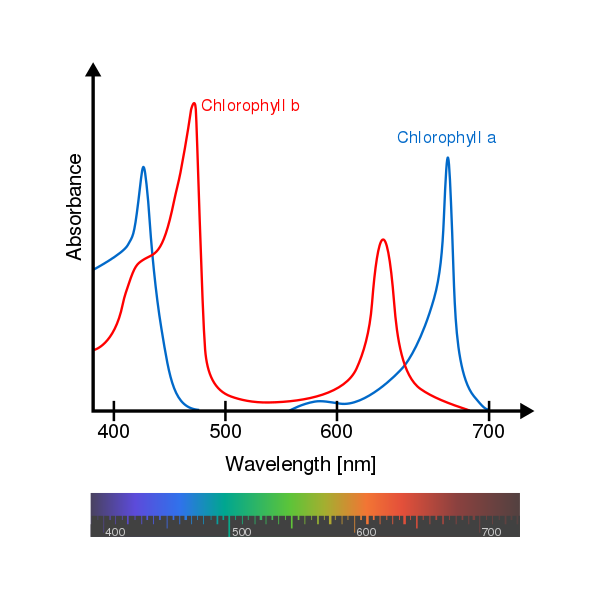
Chlorophyl gives the plant a green color, because it doesn't absorb the wavelengths for green light. A chameleon can change which wavelengths are reflected, by changing the distance it's nanocrystals have to each other.
Different layers, different functions
This structural change due to the texture of their skin, leads to a selective reflection of certain lightwaves, each depending on varying situations. It can be seen as a selective mirror, absorbing and reflecting the colors which are appropriate at the moment. The researchers have divided the two layers of iridophore cells (sometimes also called "guanophores") into superficial "S-iridophores" and deep "D-iridophores". S-iridophores are able to rapid structural colour changes through active tuning of guanine nanocrystal spacing in a triangular lattice, whereas the D-iridophores on the other hand, seem to be larger and kind of disorganised crystals. Comparing the crystal structure of a panther chameleon (Furcifer pardalis) in two different states, scientists were able to capture the different distances between crystals by utilising different measurement systems and microscopes, including transmission electron microscopy (TEM).
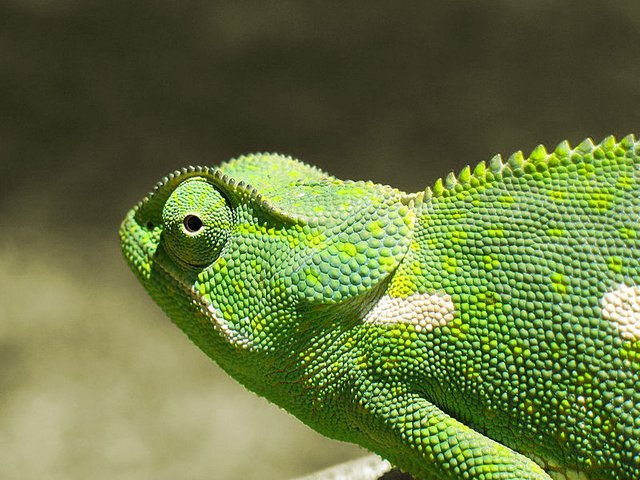
In a calm state, green is a very common color they display. Other species of chameleons are more brown and therefore better adopted to their surroundings, living near mud or sand.
What use cases for a color change has a chameleon?
Using this color change ability, chameleons can communicate with other members of their species. Their change of color is often the result of a reaction when feeling threatened or to impress and attract a partner. For females color changes can indicate a pregnancy and prevents males from mating with the female. On the other hand chameleons also profit from using dark colors e.g. in the morning to absorb much sunlight, because they are ectotherms and therefore rely on external heat sources. Vice versa, when there is much sunlight, they change their skin to brighter colors to avoid getting to warm. Additionally, chameleons also change their color due to other environmental factors such as a day-night-rythm or humidity. In a relaxed state, mostly blue light is reflected as the nanocrystals are close to each other in this phase. In addition, their skin contains yellow pigments and the combination of the two colors is the reason for a chameleon to appear green. This green color can be seen as a camouflage, being surrounded by plants and leaves where green isn't a flashy color. Brighter colors, for example yellow or red, are reflected if the distance between the crystals increases through excitement/stretching of the skin.
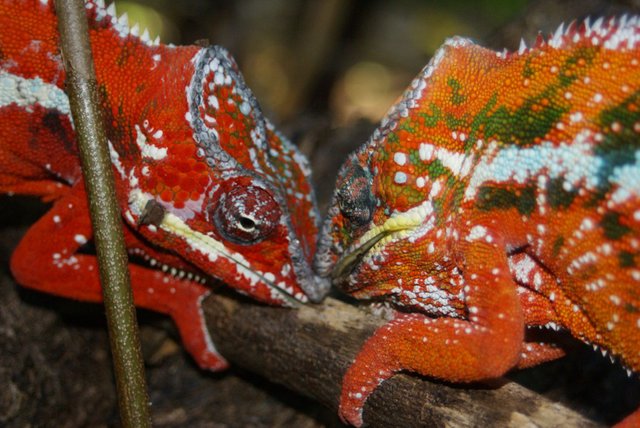
Red, orange and other bright colors can appear in situations when two chameleons are in rivalry (like it could be the case in the situation above).
Iridophores are also found in the wings of butterflies or appear in different kinds of fishes, reptiles or amphibians. Zebra fishes use them to change their stripes. Many applications can be derived from this phenomena. Scientists are trying to implement this natural process into a artificial skin made up from copolymers that reflect different wavelengths in relation to their distance from each other. Maybe some of them will be color changing clothes or other creative products.
Thanks for reading and
Have a nice day :)
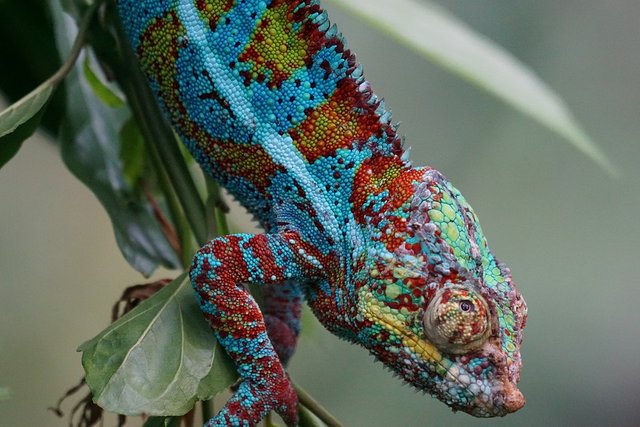
Source:
TextThe study: Teyssier, J. et al. Photonic crystals cause active colour change in chameleons. Nat. Commun. 6:6368 doi: 10.1038/ncomms7368 (2015). https://www.spektrum.de/news/wie-kommt-die-farbe-ins-chamaeleon/1336016 (translated)https://en.wikipedia.org/wiki/Chameleonhttps://asknature.org/strategy/skin-changes-color-2/#.W4mLrM4zYuVhttps://www.wired.com/2014/04/how-do-chameleons-change-colors/https://de.wikipedia.org/wiki/Cham%C3%A4leons (translated)https://www.smithsonianmag.com/smart-news/we-finally-know-how-chameleons-change-their-color-180954527/https://www.theguardian.com/science/2015/mar/10/scientists-find-out-how-chameleon-changes-colourhttp://www.bbc.com/earth/story/20150813-the-truth-about-chameleonshttps://news.nationalgeographic.com/2015/08/chameleon-colors-reflect-their-emotions/https://phys.org/news/2015-03-chameleon-nanocrystals.htmlhttp://www.sciencetimes.com/articles/4056/20150311/what-are-iridophores-and-how-are-they-keeping-chameleons-camouflaged.htmhttps://www.livescience.com/62191-artificial-chameleon-skin-is-weird.htmlPictures:https://cdn.pixabay.com/photo/2017/08/15/20/54/chameleon-2645504_960_720.jpgCredit: M0tty https://upload.wikimedia.org/wikipedia/commons/thumb/2/23/Chlorophyll_ab_spectra-en.svg/600px-Chlorophyll_ab_spectra-en.svg.pngCredit: Ridard https://upload.wikimedia.org/wikipedia/commons/thumb/9/9a/Chameleon_2006-01-contrast.jpg/800px-Chameleon_2006-01-contrast.jpghttps://upload.wikimedia.org/wikipedia/commons/b/bc/Furcifer_pardalis_02.jpghttps://cdn.pixabay.com/photo/2015/12/18/15/35/animals-1098676_960_720.jpg
Interesting topic. One thing which I feel to mention: I would personally like to give image credits right after the respective figure. Rather than giving it at the bottom of the article. Just a suggestion. :)
I already thought of that too. Thanks for your suggestion, i will do it in my next post :)
This post has been voted on by the steemstem curation team and voting trail.
There is more to SteemSTEM than just writing posts, check here for some more tips on being a community member. You can also join our discord here to get to know the rest of the community!
Hi @aximot!
Your post was upvoted by utopian.io in cooperation with steemstem - supporting knowledge, innovation and technological advancement on the Steem Blockchain.
Contribute to Open Source with utopian.io
Learn how to contribute on our website and join the new open source economy.
Want to chat? Join the Utopian Community on Discord https://discord.gg/h52nFrV
Thank you so much for this post! I really enjoyed it and have included it in the third episode of Biomimicry Inspirations.
Thanks a lot for including me in your post :)
My pleasure! Looking forward to more!!
Congratulations @aximot! You have completed the following achievement on the Steem blockchain and have been rewarded with new badge(s) :
Click on the badge to view your Board of Honor.
If you no longer want to receive notifications, reply to this comment with the word
STOPDo not miss the last post from @steemitboard:
Congratulations @aximot! You received a personal award!
You can view your badges on your Steem Board and compare to others on the Steem Ranking
Do not miss the last post from @steemitboard:
Vote for @Steemitboard as a witness to get one more award and increased upvotes!